Amateur radio aka Ham radio: Traditionally the noble art of talking to some random stranger on some other place on the planet not because you are particularly interested in them as a person but because you both get a buzz from doing something that is actually quite remarkable. Certainly you could contact them on your mobile phone or the internet but that involves masses of somebody else's masts, cable technology and infrastructure around the world where as all I will use for this is in my house, on my roof and in my garden and all they use is similarly at their home.
The other side of the coin is short range communications, still often random but it usually supports a local community of other radio
OK, I'm not going to claim that I'm at the 'cutting edge' any more, as I was when I was employed as a new graduate the in making of commercial and military communications equipment and cared about phase stability in oscillators and the noise floor of mixers. This picture shows my current equipment and much of it is 1980s, even 1970s, technology because I quite like that sort of stuff as it is both upgradable and repairable. I am also a bit of a 'vintage audio' equipment fan too for much the same reasons.
So, where did it all begin for me?
Well I first started delving into electronics and radio at about the age of twelve, so from about 1962 onwards. I started with a few shillings worth of parts and made a crystal radio. With a piece of wire draped round the garden I got the BBC Home Service on Medium Wave in an earpiece. That great feeling of 'I did this myself' was the exciting thing. Making things, I admit, has always carried a buzz for me.
Then it was to the school library where I found a book that was at about my level and that introduced me to the valve. This was the magic ingredient that made all this stuff work. The book also mentioned those new-fangled transistor things but everywhere I looked I saw valves. Here I discovered how a valve worked and, from the wreckage of a defunct TV set, I extracted the all glass EF91s and I could see all the bits inside and it was a pentode just like in the book. An EF91, a home wound coil and some bits from the local radio store gave me a super-regenerative receiver. Now I had multiple quite local BBC radio stations because it actually tuned well enough to discriminate between them.
About this time I discovered, or actually my father discovered for me, Practical Wireless magazine. This offered me not only articles at my level but the heights to aspire too like Amateur radio. Every month it came and fuelled my growing interests. It also contained the trick to actually achieving these things - the advertisements for components.
Then, at about fifteen I think, actually as a Birthday present I got a real radio. It was the classic gateway drug to hobby radio at the time, the war surplus 19 set (A Canadian MK III for those that understand, the version with the Russian second language on the front panel). It is usually described as a tank radio, although there were other versions. It contained three sections: A local intercom, so the tank crew could talk to one another over all the noise, a 230MHz VHF short range tank to tank set so a platoon could stay coordinated and a 2-8MHz short wave set to talk, or use morse, to contact base. That last section was the bit you wanted.
As an avid reader of anything 'teach yourself' I knew about single sideband and why it definitely was the way to go. I carefully studied the 12 month 'How to pass your Radio Amateurs license exam' series in the magazine, did all the test questions and I knew my stuff. However I didn't know how to get to get to take the exam so the whole business rather floundered there.
Jump forward from the late 60s to 1972 and having done a dose of University of Sussex maths/physics I was adding some Electronic Engineering at Brighton Polytechnic to my education. One of the first guys I met in my group there was a radio amateur. I mentioned, sadly, how I had always wanted to do that but how do you actually get to take this exam? Of course he knew. Walk into the office in the local Technical college, put your money on the table and you're booked in. The next exam is in a few weeks so go as soon as possible. If I had only known it was that simple...
Well I did know my stuff and I passed and that turned me into G8JFT. A VHF/UHF license because in those days you needed a qualification in morse to be let on the HF (aka short wave) bands. A reworked VHF ex-taxi radio launched me into the quite busy 'Two Meter' band thing we had going in those days. I came to participate in the setting up of the two Brighton repeaters and was the first Secretary when we founded the Brighton and District Radio Society, although sadly they are all gone now. Graduating with a degree in Electronic Engineering and working in the business I had access to parts, to test equipment and to people who had worked professionally in radio for decades for professional advice. I had many good years of radio fun but as my interests developed into computers and a developing family it rather took a back seat in my life. Finally, when I moved from the top of the hill to the bottom of the hill, my VHF activity dropped away and although I did continue to teach the license exam class for the club for some years longer sadly, after about ten good years, Amateur radio progressively faded out of my life.
But now
So, well a further forty years later, I am now retired, a widower and the kids have grown up and left home so I have nobody left to tell me not to do silly things like this. Hence I have started it all up again. As I progressively outgrew the more physically demanding pastimes of motorbike racing, scuba diving, caving and the hang gliding it rather faded back into my thinking.
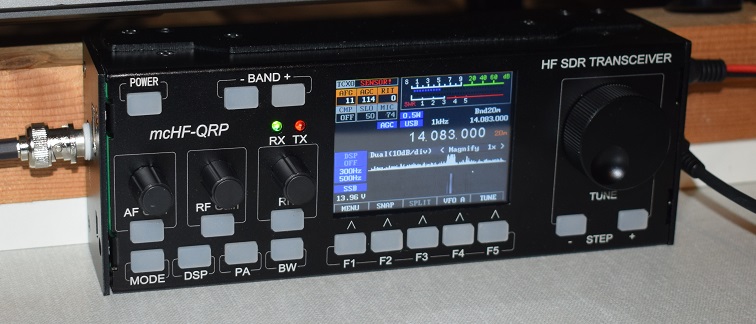 Well, let's admit it, although I am still living at the bottom of the hill, not
really a good VHF radio location, the thing that really triggered this second
renaissance was reading about Software Defined Radio (SDR). The idea is that
you down convert to an Intermediate Frequency of 0Hz but as a quadrature pair
so you avoid loosing important things like the sign of the frequency (yes,
negative frequency is a thing) and then transform that signal into a digital
stream so you can perform all your signal conditioning and resolving in
software rather than on electronic components. The kid programmer I still have
in me just went WOW at that and then, when I discovered it didn't take scary
chips but just the same microprocessors that I was already familiar with,
double WOW!
Well, let's admit it, although I am still living at the bottom of the hill, not
really a good VHF radio location, the thing that really triggered this second
renaissance was reading about Software Defined Radio (SDR). The idea is that
you down convert to an Intermediate Frequency of 0Hz but as a quadrature pair
so you avoid loosing important things like the sign of the frequency (yes,
negative frequency is a thing) and then transform that signal into a digital
stream so you can perform all your signal conditioning and resolving in
software rather than on electronic components. The kid programmer I still have
in me just went WOW at that and then, when I discovered it didn't take scary
chips but just the same microprocessors that I was already familiar with,
double WOW!A google about on the web started to show that there were ready made and pre-programmed SDR receivers but thankfully there were tutorials on SDR programming and, as I already have a strong background in maths and computers, they were easy. However I soon found some rather interesting versions of a compact low power HF transceiver using SDR but one reviewer linked me back to the bunch of guys who actually designed it and have a multi-year project running to expand and enhance things. Since they have generously open sourced the whole design and code but requested not for commercial use I rather abandoned interest in the commercial versions and moved my sights to their project.
The software is on GitHub as UHSDR. I think the instructions for downloading and compiling this have problems but I got it done.
They had an example transceiver the code will run on available in kit form as mcHF. The commercial units that I was initially looking at appear to be very directly
I timed it badly. The world was busy doing COVID-19 not transceivers and the kit was out of stock until the end of the month. I'm not good at waiting for things, I never have been, so I ordered the case and some accessories and tried to set up the open source firmware archive so I could compile it.
Well my mcHF kit came and as I have years of designing and building electronics plus the tools to do it, including a full SMD rework set up at home, it went together quite quickly. I did have some issues with fitting the boards into the case but I think that might be the cheap case I bought was missing some spacers. I redesigned the mountings and bought my preferred bolts, standoffs and the right knobs to match my encoders and it all went together. I rather like it.
More to follow....
What else?
Specifically what about the rest of the pile in my lead picture?
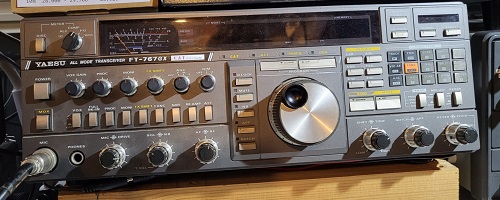
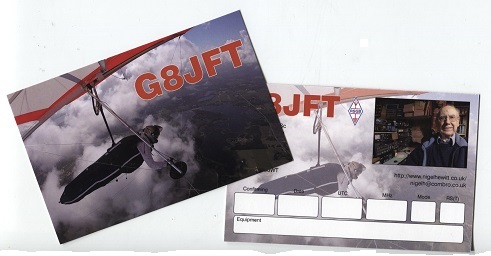 Well I had bought the FT-767GX and some of the other bits a while before but it
was cheap second hand and had some problems. I was looking for fixes when I
started to see 'sensibly' priced FT-101 stuff. OK it's old but then so am I and
it's pretty standard electronics rather than annoying custom chips. I can open
it up, pick up a soldering iron, make a repair or wire in a modification very
easily.
Well I had bought the FT-767GX and some of the other bits a while before but it
was cheap second hand and had some problems. I was looking for fixes when I
started to see 'sensibly' priced FT-101 stuff. OK it's old but then so am I and
it's pretty standard electronics rather than annoying custom chips. I can open
it up, pick up a soldering iron, make a repair or wire in a modification very
easily.This drove me to rearrange the 'shack', the place where my radio gear lives. Rather than being all nicely laid out but at the totally wrong end of my office where I didn't even have a place to sit I moved it to just behind my desk. Suddenly it was all immediately to hand and crying out to be used. The picture at the top is a recent version of this but it keeps getting rearranged.
Things were beginning to look respectable now and after talking to some local people the idea of actually getting a bit more serious again was looking up. One of the things I did was to splash out on a sexy new QSL card as the old one was horrible and the few I had left were going a bit brown at the edges. Getting printing done, now we have the internet, is so much easier so I have a coloured double sided thing with pictures.
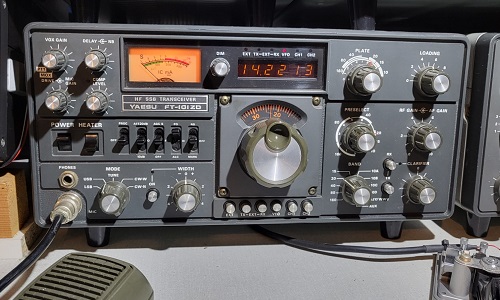 The main 'new' item is the FT-101ZD. That was the big rig in my youth and,
working in the radio manufacturing business at the time and caring about mixers
and noise floors I knew it was pretty good. This is a 9D serial number model so
it dates from February 1979 and so doesn't have the WARC bands but it is
immaculate inside and out. I have invested in a capacitor kit, that improved
the vintage hi-fi preamp quite noticeably and this is of a similar vintage, but
it still a job waiting time to do. Once I had it I added FT101 accessories to
my Ebay 'watch for' list and soon found the matching
The main 'new' item is the FT-101ZD. That was the big rig in my youth and,
working in the radio manufacturing business at the time and caring about mixers
and noise floors I knew it was pretty good. This is a 9D serial number model so
it dates from February 1979 and so doesn't have the WARC bands but it is
immaculate inside and out. I have invested in a capacitor kit, that improved
the vintage hi-fi preamp quite noticeably and this is of a similar vintage, but
it still a job waiting time to do. Once I had it I added FT101 accessories to
my Ebay 'watch for' list and soon found the matching
FV-101Z VFO
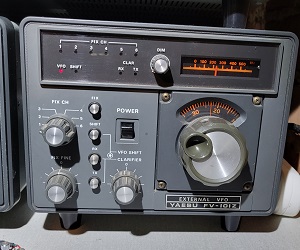
and the

YO-100 Monitor Scope
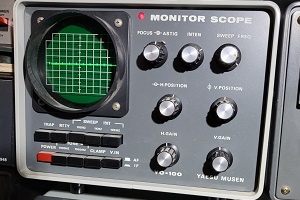
.
I already had the

FL-2100Z Linear
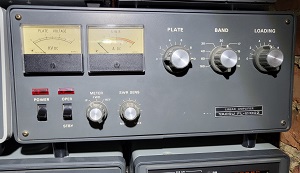
with a lovely pair of grounded grid triodes - yes, I still have a weakness for
valves. Consider this a work in progress.
The FT101ZD has become my rig of choice because it's so simple. There are no wonderful gadgets to distract you as you slowly roll across the band that my preferred software says should be open. It's me as operator doing the selection and me doing the QSO. This is how I remember ham radio and it's quite good.
However there is the matter of aerials. Good aerials are key to radio success. The poor old VHF rotator system that I brought from the 'top of the hill' and installed here had seen many decades of neglect and far too much rain. Hence the combination of steel and aluminium in contact had generated lots of horrible white oxides so the sleeve through the roof was a serious mess and although the rotator looked pretty sad on the outside a strip and clean revived it. I just had to admit that it was time to buy stuff rather than bodging around on the cheap.
For the current state of the ongoing aerial story see the aerials page.
And then I rather impulse purchased a used Icom IC-7000
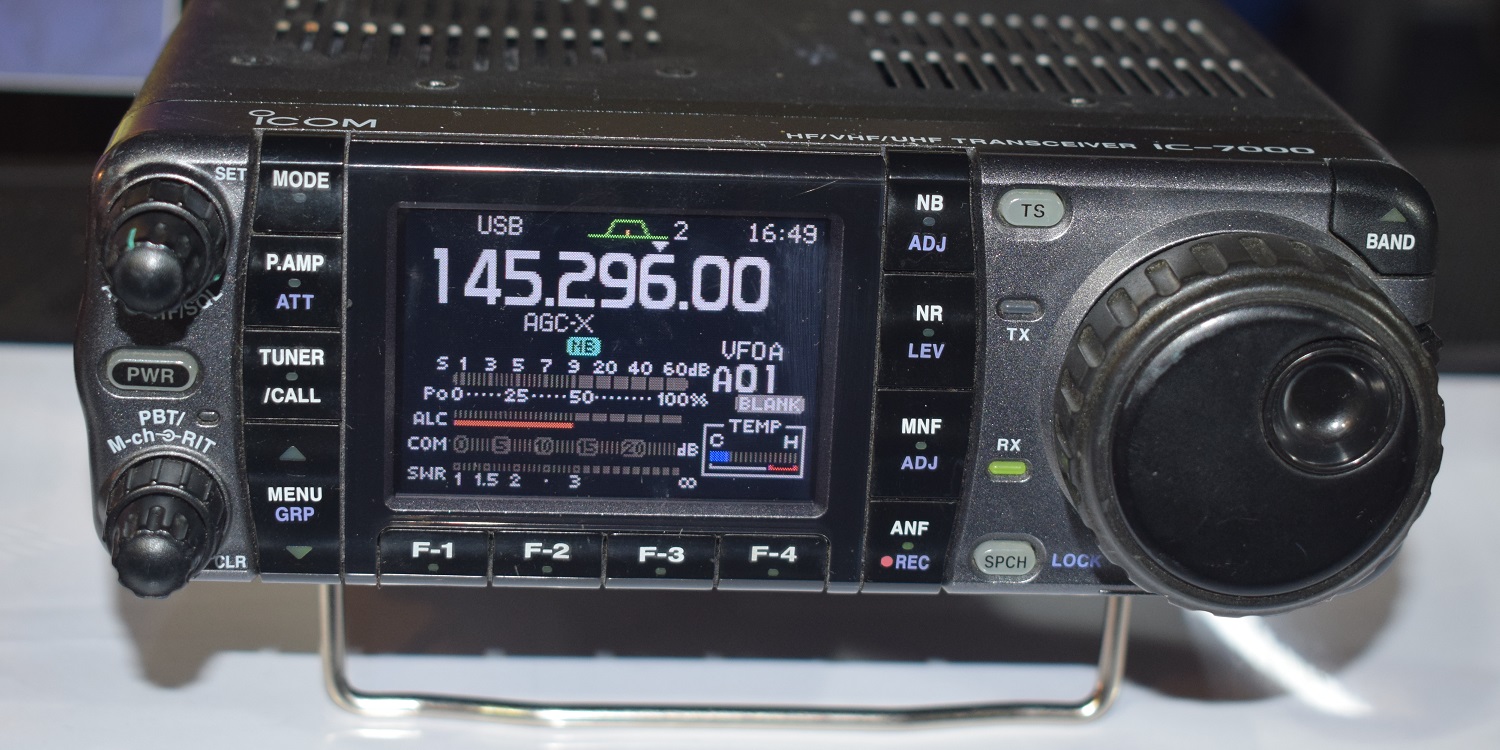 |
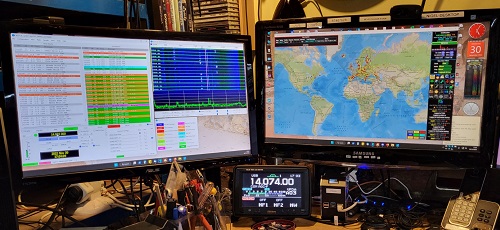 |
 Well actually two of them but the first one had a fault that I'm in the midst
of fixing. Sadly 0805 SMD parts and smaller don't work well with my fumbly old
fingers and my dodgy old eyes so it's a bit slow going. This is why most of my
other gear is nice and old and made of reasonably sized components. However I
did rather fancy the mix of HF/VHF/UHF with multi-mode and reasonable power so
when I saw another I bought that too. Watch this space for the repair blog
(unless it all blows up in which case I'll deny it ever happened).
Well actually two of them but the first one had a fault that I'm in the midst
of fixing. Sadly 0805 SMD parts and smaller don't work well with my fumbly old
fingers and my dodgy old eyes so it's a bit slow going. This is why most of my
other gear is nice and old and made of reasonably sized components. However I
did rather fancy the mix of HF/VHF/UHF with multi-mode and reasonable power so
when I saw another I bought that too. Watch this space for the repair blog
(unless it all blows up in which case I'll deny it ever happened).So what's so good about it and why don't they seem to make something like that anymore?
At the time I wanted something that would do mobile or at least portable but I wanted it to have a 'reasonable' amount of power and definitely be multimode. Frankly I wanted to be able to take it somewhere that wasn't down my hole in the ground and work stuff. Well also I wanted it to have toys, lots of toys.
One of the things that attracted me to it was the sockets on the back. I could see standard, not weird proprietary, connectors for connecting the CAT interface and bringing the modulation in and out ready to interface to my computers. OK the idea of a video output rather amused me so I dug about in my old junk and found old camera monitor and plugged that in and it worked first time. I'm not sure I have any need for it but it's a wonderful addition to my collection of playthings.
However... As time progresses and I'm getting back into things I'm pretty sure it isn't going to become the mobile rig. That only really needs a 2/70 FM box with a hands-free mike. The IC-7000 seems to be becoming the data mode rig as it covers all the bands I'm interested in for those modes with sufficient power to do the job and the interfacing it is just an off the shelf connector box with plugs and cables with a top flight DAC/ADC card and most of the control s/w recognises it as an Icom standard interface. Currently I'm using it to play FT-8 Bingo and I'm ticking of the countries of Europe and even beyond on HF plus lots of squares. The video screen meshes quite nicely with that as a display positioned under the monitors where all the work real is done. The heavy duty cycle of data meant that it started cutting out on transmit after an hour or so on a busy day so that does mean that it certainly benefited from adding
a pair external fans

tucked up under the heat sink which
have kept it happy all day although I have to admit with a problem with
transmitted RF annoying the USB3 extender I use to control it.
Working FT-8 effectively calls for getting the right software to suit your style and implementing it carefully. Currently my choice is WSJT-X to do the actual RF/audio donkeywork and then GridTracker to 'see what I'm working/have worked'. Both are free downloads from the web. I also have GridTracker configured to live upload my contacts to the ARRL's Logbook of The World and to eQSL. This means I can get 'officially' confirmed countries and squares as they match up my entries with the other people's so I don't really need my pretty QSL cards.
Incidentally if you want to connect more devices to the WSJT-X output, like I did, and need a UDP distributor I wrote one. There's yet another ADIF log file reader there too.
Just take the Windows installer msi files if you're not into source code.
Secondly set it up right. Do not just bung in the plugs and because you can work an Italian assume it works perfectly. Set the transmit output to just hit the rig's compressor so your output is full power but not distorting (on WSJT-X this is the slider on the right). Then tune the audio input gain on the PC for best dynamic range, which is probably means reduce it a lot from a microphone setting. On WSJT-X I can conduct a QSO down to level -27 signals and my noise floor is way lower than most...
Finally run some decent power. Yes, there is a buzz in saying "did it all on QRP" but that's not you being clever - that's you working people like me struggling to pick your trashy signal out of the noise. Also know your transmit and receive audio bandwidths. The IC-7000 transmit will not work happily on audio over 2800Hz so I have WSJT-X set to 'Split operation: Rig' so it uses the CAT to retune the transmitter to an optimum frequency. Also I need to select a wide Rx filter. Conversely slipping in a CW notch filter to take out a strong in band signal gives the AGC more room to play and pick out the weak ones.
And finally put yourself on the reporting groups, I would recommend HamQTH, LoTW and eQSL. You can get all of that for free, please, ALWAYS call with your square, don't short cut it straight to the signal reports. A lot of us collect squares and we want them confirmed so throw us a bone here.
Currently my FT-8 exploits, as at the time of writing, quite please me and I'm having a lot of fun. For example my 20 meter log, for just the first month as I was learning, contains the totals below for worked (in my log) and confirmed (via LoTW). Here is a rather large screen shot of the map of my log with yellow for logged (exchanged reports and OKed) and red for confirmed. Currently there are a growing list of 'the ones that got away' (ie never completed normally because of a pile up or just plain 20m giving up) but I'm watching for them.
| From | 21 Nov 2022 | to | 20 Dec 2022 |
| Worked | Confirmed | ||
| Callsigns | 1201 | 443 | |
| Grids | 588 | 306 | |
| DXCCs | 99 | 72 | |
| US States | 21 | 13 | |
| Continents | 6 | 6 |
I tried really hard to get up to the magic number of 100 DXCC entities worked but I can already see things slowing down a lot. I expect that getting the last ten confirmed is going to be about as hard as the previous ninety. C'est la vie.
Is it too awful to admit that working a mode like FT-8, where you don't actually have to talk to anybody, rather suits me?
By Nigel Hewitt G8JFT